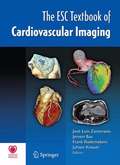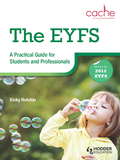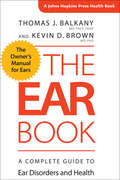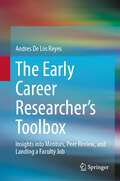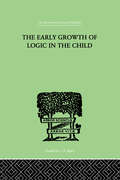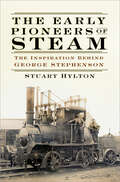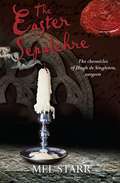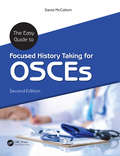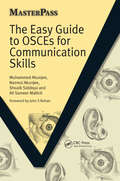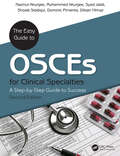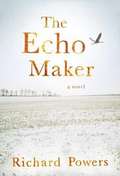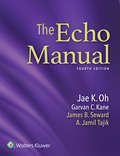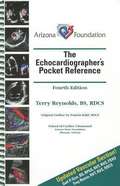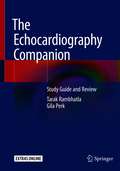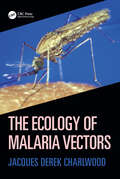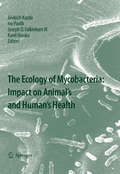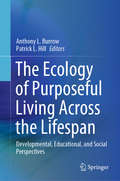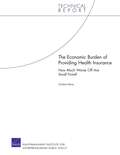- Table View
- List View
The ESC Textbook of Cardiovascular Imaging
by Jeroen J. Bax Frank E. Rademakers Jose Luis Zamorano Juhani Knuuti"The ESC Textbook of Cardiovascular Imaging" is a comprehensive guide to all forms of cardiovascular imaging. A disease based approach is followed and the book is comprised of 8 sections. Section 1 describes the imaging techniques available and Sections 2-8 describe the imaging modalities used to visualise cardiovascular diseases in seven main areas. Each section is subdivided into 2-7 chapters. The book is edited by four European opinion leaders in the fields of echocardiography, nuclear, CMR and CT imaging and has over 50 contributors, mainly from Europe. The printed version is complemented by a basic online version, accessible by means of a password, distributed with the book. The online version allows users to: download chapters for ease of use; provide links from all references to PubMed; allow searching of the text; and download figures and images for non-commercial use in PowerPoint presentations.
The EYFS: A Practical Guide for Students and Professionals
by Vicky HutchinEndorsed by CACHE, this is the ideal book for you if you are an early years professional, a Level 2 or Level 3 child care learner, are working in a pre-school or are working as a child minder. This book will de-mystify the revised 2012 Early Years Foundation Stage, and show how you can deliver the new EYFS using the best and most effective standards of professional practice.Each chapter explains a key theme of the EYFS and follows the same model to ensure ease of reading: 'Understanding this theme', 'Looking at children', 'What the experts say' and 'Effective practice'.The most important theory and research relating to each aspect of the EYFS is clearly and simply explained, and suggestions as to how this can influence effective practice are included.Links between child development and the EYFS are demonstrated using carefully analysed observations of children at different ages, highlighting not only common themes but also the uniqueness in every child's learning and development. Case studies in every chapter provide practical examples of best practice and activities help you reflect on and develop your own practice.
The Ear Book: A Complete Guide to Ear Disorders and Health (A Johns Hopkins Press Health Book)
by Thomas J. Balkany Kevin D. BrownThe owner’s manual for ears.Intricately shaped and amazingly sensitive, ears are the organs of hearing and balance. When something goes wrong with the ears—whether infection or cancer, eardrum perforation or hearing loss—our overall well-being is generally disturbed.In The Ear Book, Drs. Thomas J. Balkany and Kevin D. Brown, recognized experts on ears and hearing, explain how the anatomy of the ear facilitates hearing and balance and then examine the causes, symptoms, and treatment of common problems of the outer, middle, and inner ear. Their explanations take the mystery out of hearing aids, the proper care of ears, and how the pressurized conditions of scuba diving and air travel affect the ears. And they debunk ear-related myths—from the notion that exposure to loud noise strengthens the ear to the idea that tinnitus can be cured with nutrients—and urge readers to stop using ear candling or Q-tips to get rid of wax.Drs. Balkany and Brown address such common questions as: Can dizziness be cured? How loud is too loud? Why do my ears ring? Do cochlear implants work for nerve deafness? What promise do innovations in gene therapy and stem cell therapy hold for the future? Fully illustrated and including helpful tables, hearing preservation tips, a glossary of terms, lists of ear medications and resources, and suggestions for further reading, The Ear Book is sure to be a welcome family guide.
The Ear Book: A Complete Guide to Ear Disorders and Health (A Johns Hopkins Press Health)
by Thomas J. Balkany Kevin D. Brown“Everything you ever wanted to know about ears from two outstanding physician scientists. I loved this book!” —Donna Shalala, Former U.S. Secretary of Health and Human ServicesIn The Ear Book, Drs. Thomas J. Balkany and Kevin D. Brown, recognized experts on ears and hearing, explain how the anatomy of the ear facilitates hearing and balance and then examine the causes, symptoms, and treatment of common problems of the outer, middle, and inner ear. Their explanations take the mystery out of hearing aids, the proper care of ears, and how the pressurized conditions of scuba diving and air travel affect the ears. And they debunk ear-related myths—from the notion that exposure to loud noise strengthens the ear to the idea that tinnitus can be cured with nutrients—and urge readers to stop using ear candling or Q-tips to get rid of wax.Drs. Balkany and Brown address such common questions as: Can dizziness be cured? How loud is too loud? Why do my ears ring? Do cochlear implants work for nerve deafness? What promise do innovations in gene therapy and stem cell therapy hold for the future? Fully illustrated and including helpful tables, hearing preservation tips, a glossary of terms, lists of ear medications and resources, and suggestions for further reading, The Ear Book is sure to be a welcome family guide.“This book is gem for everyone with questions about their ears. I highly recommend it—especially the chapter on Myths of the Ear!” —D. Bradley Welling, MD, PhD, Harvard University Department of Otolaryngology
The Early Career Researcher's Toolbox: Insights into Mentors, Peer Review, and Landing a Faculty Job
by Andres De Los ReyesThis book probes professional development issues crucial to early career researchers, beginning with advice on selecting mentors and optimizing mentoring relationships. From this foundation, the book describes how to navigate the peer-review process, particularly when publishing in academic journals, as well as build connections between the different pieces of academic work published during the early career years. It details strategies to leverage the tools of storytelling to build a research program coupled with concrete guidance on delivering job talks during academic job interviews. In addition, the book includes a feature, Anonymous Accounts, which provides real-life examples of how early career researchers experienced many aspects of their training and illustrates how to overcome obstacles on the path to success in the academic job market.Key topics featured include: Selecting and working with mentors. Navigating peer review when publishing in academic journals. Building a research program. Delivering academic job talks. The Early Career Researcher’s Toolbox is a must-have resource for graduate students, post-doctoral fellows, and aspiring undergraduate students as well as all early career and other professionals in search of a resource designed to help them succeed in the academic job market.
The Early Childhood Care and Education Workforce
by Institute of Medicine National Research Council Division of Behavioral and Social Sciences and Education Board on Children, Youth and Families Committee on Early Childhood Care and Education Workforce: A WorkshopEarly childhood care and education (ECCE) settings offer an opportunity to provide children with a solid beginning in all areas of their development. The quality and efficacy of these settings depend largely on the individuals within the ECCE workforce. Policy makers need a complete picture of ECCE teachers and caregivers in order to tackle the persistent challenges facing this workforce. The IOM and the National Research Council hosted a workshop to describe the ECCE workforce and outline its parameters. Speakers explored issues in defining and describing the workforce, the marketplace of ECCE, the effects of the workforce on children, the contextual factors that shape the workforce, and opportunities for strengthening ECCE as a profession.
The Early Growth of Logic in the Child: Classification and Seriation (International Library Of Psychology Ser.)
by Inhelder, Brbel & Piaget, JeanFirst published in 1999. Routledge is an imprint of Taylor & Francis, an informa company.
The Early Pioneers of Steam: The Inspiration Behind George Stephenson
by Stuart HyltonWe think of the Stephensons and Brunel as the fathers of the railways, and their Liverpool and Manchester and Great Western Railways as the prototypes of the modern systems. But who were the railways’ grandfathers and great-grandfathers? The rapid evolution of the railways after 1830 depended on the juggernauts of steam locomotion being able to draw upon centuries of experience in using and developing railways, and of harnessing the power of steam. Giants the Stephensons and others may have been, but they stood upon the foundations built by many other considerable – if lesser-known – talents. This is the story of those early pioneers of steam.
The Easdale Doctor: The Life and Times of Patrick H. Gillies
by Mary WithallAn inspiring biography of a Victorian-era physician who gave up the promise of fortune and glory to serve his small community on a Scottish island. When Patrick Gillies graduated from the University of Edinburgh&’s distinguished school of medicine with honors in 1890, a high-profile career as a surgeon lay ahead of him. Any city across the world would have welcomed him, and his university mentors, including the famous Joseph Lister, urged him to take up one of these opportunities. But Gillies defied them all and returned to his hometown of Easdale, determined to continue the work his father had begun as a physician to the parishioners of Scotland&’s Slate Islands. Over the next forty years, Patrick Gillies worked tirelessly to sustain and improve the community. While working as a General Practitioner, he involved himself in the needs of Easdale, fighting the closure of the local school as a member of the school board, and applying his expertise and determination to public health issues, working to build an isolation hospital and provide better medical care for children. Eventually, he would serve his country as well, in Army service in two wars. This biography is a portrait of a quiet hero, a tale of a dedicated doctor who stayed in a small town—and made a big difference.
The Easter Sepulchre: The Thirteenth Chronicle of Hugh de Singleton, Surgeon (Hugh de Singleton, Surgeon #13)
by Mel StarrKeeping watch over the Easter Sepulchre, where the Host and crucifix are stored between Good Friday and Easter Sunday, is considered a privilege. So, it is shocking when it is discovered that Odo, the priest’s clerk, has abandoned his post. But as the hours pass and Odo is not found, Hugh de Singleton is called upon. It is Hugh that finds the dried blood before the altar, and fear grows for the missing man... Will Hugh be called upon to investigate another murder, or will the man be found hale and hearty? But if so, where has the blood come from?
The Easy Cannabis Cookbook: 60+ Medical Marijuana Recipes for Sweet and Savory Edibles
by Cheri SicardThe definitive guide to making easy, everyday ediblesGo beyond just cookies and brownies as you learn how to serve up delicious edibles perfect for every meal with this comprehensive exploration of cooking with cannabis.Written by Cheri Sicard—nicknamed the "Martha Stewart of weed" by The Daily Beast—this cannabis cookbook provides you with absolutely everything you need to redefine stoner eats. Whether it's Ganja Gazpacho, Barbecue Chicken, or Deviled Eggs, these simple and straightforward recipes make it a breeze to bring unique, properly dosed edibles to the table.This must-have marijuana cookbook includes:Cannabis 101—Discover a crash course on the history of marijuana and all the benefits it provides.Dosing guides—Find out how to measure potency and make sure your infusions meet their mark.Cooking fundamentals—Learn fundamental cooking skills, what equipment you need, and more.60 Tasty recipes—Go beyond cookies and brownies with recipes for breakfasts, lunches, dinners, and more.Get baked, roasted, and grilled cannabis-infused treats for every meal thanks to The Easy Cannabis Cookbook.
The Easy Guide to Focused History Taking for OSCEs, Second Edition
by David MccollumThis straightforward guide to taking patient history comprehensively covers all of the commonly seen OSCE scenarios within the current undergraduate medical curriculum. The Easy Guide to Focused History Taking for OSCEs includes introductory chapters with general OSCE guidance, mapping onto the Calgary-Cambridge model. These include tips from recently qualified doctors and highly respected physicians and surgeons who commonly examine OSCEs, as well as a sample OSCE marking scheme. ? The book then covers 56 histories based on presenting complaints - more than any other text on the market - thoroughly testing both knowledge and examination technique. Each history is based around the exam requirements, with mnemonics, ‘red flag’ symptom boxes and list-based breakdowns to aid prompt recall. Common and serious differentials are highlighted, as well as investigations to help rule out the serious conditions. Each section concludes by outlining key aspects for each differential diagnosis as well as a list of investigations and management options. ? With this book, every student will be well equipped to tackle any clinical problem, in the OSCE examination and also in their continued professional practice.
The Easy Guide to OSCEs for Communication Skills
by Muhammed Akunjee Nazmul Akunjee Shoaib Siddiqui Ali Sameer MallickIt is increasingly recognised that communication plays a pivotal role in obtaining successful clinical outcomes. However, despite an increase in communication skills teaching, much of literature on this topic is targeted at senior doctors and researchers, and many medical students still find demonstrating competence in communication skills OSCEs a challenge. This book lightens the load by simplifying communication skills, explaining key theories and concepts simply and illustrating them through practical role plays. It covers a wide variety of common dilemmas in clinical and examination settings, and tackles challenging and increasingly familiar areas such as cross-cultural sensitivities, communicating with a patients whose first language is not English, and communicating with patients who have complaints about their treatment.
The Easy Guide to OSCEs for Final Year Medical Students, Second Edition (MasterPass)
by Muhammed Akunjee Nazmul Akunjee Dominic Pimenta Dislan YilmazThe final year Objective Structured Clinical Examinations (OSCEs) test a broad range of practical skills, knowledge, examination technique and communication abilities, and can be a daunting prospect. The Easy Guide to OSCEs for Final Year Medical Students covers, in a self-assessment format, over 99 sample OSCE stations including the standard history, examination and general skills stations. This edition includes additional commonly examined cases and instruction on how to interpret a paper. With newly created colour illustrations and clinical photographs, the clear layout and easy-to-read style prepares students for the examination environment and focuses on the specific areas and responses examiners look for.
The Easy Guide to OSCEs for Specialties: A Step-by-Step Guide to Success, Second Edition
by Dilsan Yilmaz Dominic Pimenta Muhammed Akunjee Nazmul Akunjee Shoaib Siddiqui Syed JalaliThis second edition of the highly successful Easy Guide to OSCEs for Clinical Specialties provides a comprehensive yet succinct resource to get you through each clinical rotation, as well as the Final exam. Compiled by recently qualified doctors who have experienced the new OSCE system first hand, the book covers over 80 OSCE examination stations in a wide range of different subjects.Brand new to this edition are chapters on Psychiatry, non-accidental injury in children, and an ‘On the Wards’ section covering both Anaesthetics and Palliative Care. All management suggestions are updated in line with NICE guidance and evidence-base, and new time-saving, student friendly mnemonics have been added to make the book even more user-friendly.This book will ease the already burdensome workload of medical students, and help them pass their OSCEs to become junior doctors competent in a wide range of different skills in medical fields.
The Echo Maker
by Richard PowersOn a winter night on a remote Nebraska road, 27-year-old Mark Schluter flips his truck in a near-fatal accident. His older sister Karin, his only near kin, returns reluctantly to their hometown to nurse Mark back from a traumatic head injury. But when he emerges from a protracted coma, Mark believes that this woman–who looks, acts, and sounds just like his sister–is really an identical impostor. Shattered by her brother's refusal to recognize her, Karin contacts the cognitive neurologist Gerald Weber, famous for his case histories describing the infinitely bizarre worlds of brain disorder. Weber recognizes Mark as a rare case of Capgras Syndrome, a doubling delusion, and eagerly investigates. What he discovers in Mark slowly undermines even his own sense of being. Meanwhile, Mark, armed only with a note left by an anonymous witness, attempts to learn what happened the night of his inexplicable accident. The truth of that evening will change the lives of all three beyond recognition.<P><P> Set against the Platte River's massive spring migrations–one of the greatest spectacles in nature–The Echo Maker is a gripping mystery that explores the improvised human self and the even more precarious brain that splits us from and joins us to the rest of creation.<P> The Echo Maker is the winner of the 2006 National Book Award for Fiction.
The Echo Manual: Ebook without Multimedia
by Jae K. Oh Garvan C. KanePublisher's Note: Products purchased from 3rd Party sellers are not guaranteed by the Publisher for quality, authenticity, or access to any online entitlements included with the product. Ideal for residents, fellows, and others who need a comprehensive, clinically focused understanding of echocardiography, The Echo Manual, 4th Edition, has been thoroughly revised with updated information, new chapters, and new video clips online. Written primarily by expert authorities from the Mayo Clinic, this best-selling reference remains a practical guide to the performance, interpretation, and clinical applications of today’s echocardiography.
The Echocardiographer's Pocket Reference
by Terry Reynolds Pamela KiddI would first wish to express my deep gratitude to each of you for your continued support of this book. The fourth edition provides the newest American Society of Echocardiography recommendations for valvular stenosis
The Echocardiography Companion: Study Guide and Review
by Gila Perk Tarak RambhatlaThis is a comprehensive yet easy to read study guide for those preparing for the echocardiography board examinations, which brings all of the critical resources together into one convenient and portable resource. Echocardiography is an integral part of routine cardiology practice and this book represents a quick, yet thorough, reference that can be easily consulted to help practicing clinicians deliver high quality care to their patients. The Echocardiography Companion: Study Guide and Review includes a comprehensive educationally-focused review of the technique, its clinical uses, applications, and utilization in all cardiac conditions. The practical and quick reference format allows it to serve as a reference book and as a helpful companion to students, on which notes can be taken while studying from other resources such as board review videos.
The Ecology of Animal Senses
by Gerhard von der Emde Eric WarrantThe collection of chapters in this book present the concept of matched filters: response characteristics "matching" the characteristics of crucially important sensory inputs, which allows detection of vital sensory stimuli while sensory inputs not necessary for the survival of the animal tend to be filtered out, or sacrificed. The individual contributions discuss that the evolution of sensing systems resulted from the necessity to achieve the most efficient sensing of vital information at the lowest possible energetic cost. Matched filters are found in all senses including vision, hearing, olfaction, mechanoreception, magnetoreception and infrared sensing and different cases will be referred to in detail.
The Ecology of Malaria Vectors
by Jacques CharlwoodThis practical book covers all aspects of the biology of malaria vectors, with notes on the vectors of dengue. It is the first work in this field to concentrate on mosquitoes, rather than covering all disease vectors. Authored by renowned field entomologist Jacques Derek Charlwood, it disseminates his vast experience working on mosquito biology, ecology and the evaluation of new vector control tools across five continents over the past 40 years. Covering all aspects from classification and systematics, population dynamics, vector control, to surveillance and sampling, epidemics, and a selection of case histories, the book also considers genetics and resistance, Aedes biology, and malaria and dengue models. It is designed to fill the gap between very specialized texts and undergraduate books on general disease vectors, and is ideal as a textbook for postgraduate courses in entomology and mosquito vectors of disease.
The Ecology of Mycobacteria: Impact on Animal's and Human's Health
by Jindrich Kazda Joseph O. Falkinham III Karel Hruska Ivo PavlikThe Ecology of Mycobacteria principally emphasizes the ecological characteristics of the environmental mycobacteria. It is now well understood that the incidence and prevalence of potentially pathogenic mycobacteria is increasing in humans and animals. Further, proof that mycobacteria are normal inhabitants of drinking water distribution systems and household water systems, indicates that humans and animals are surrounded by mycobacteria and thus at risk. It is anticipated that the emphasis on ecology and routes of infection will result in a text of widespread use for clinicians and for research scientists in medicine, academia, and industry. In addition to identifying habitats and thereby sources of mycobacteria infecting humans and animals, the text identifies those mycobacterial characteristics that determine its range of habitats. Additionally, the text comments critically on the available methods to identify those protocols with values in mycobacterial research. In that manner, although there are no chapters specifically devoted to methods, superior methods for mycobacteria will be identified.
The Ecology of Purposeful Living Across the Lifespan: Developmental, Educational, and Social Perspectives
by Patrick L. Hill Anthony L. BurrowThis book explores what it means to live a purposeful life and outlines the benefits associated with purpose across different life domains. It also demonstrates that purpose in life is not reducible to constructs such as happiness, well-being, or identity development.The importance of having a sense of purpose in life is attracting renewed attention in both scientific and social arenas. Mounting evidence from intricately designed experiments and large-scale studies reveals how pursuing a purpose can make a person happier, healthier, and even lengthen their lifespan. However, existing texts on purpose have said little on why having has these effects, how it may influence our ability to navigate diverse environments, or how best to consider the construct from a multidisciplinary approach that moves beyond psychology.Recognizing this gap in the literature, this book provides multidisciplinary perspectives on the topic of purpose, and examines what we can do as researchers, interventionists, and society as a whole to imbue purposefulness in the lives of people across the lifespan. It includes contributions from key figures on topics such as identity, health, youth programs and youth purpose, diversity, aging and work.
The Economic Burden of Providing Health Insurance
by Christine EibnerMore than 60 percent of nonelderly Americans receive health-insurance (HI) coverage through employers. However, rising health-care costs may threaten the long-term viability of the employer-based insurance system. This report explores trends in the economic burden associated with HI provision for small and large businesses, as well as the quality of plans that small and large firms offer.
The Economic Evolution of American Health Care
by David DranoveThe American health care industry has undergone such dizzying transformations since the 1960s that many patients have lost confidence in a system they find too impersonal and ineffectual. Is their distrust justified and can confidence be restored? David Dranove, a leading health care economist, tackles these and other key questions in the first major economic and historical investigation of the field. Focusing on the doctor-patient relationship, he begins with the era of the independently practicing physician- epitomized by Marcus Welby, the beloved father figure/doctor in the 1960s television show of the same name-w ho disappeared with the growth of managed care. Dranove guides consumers in understanding the rapid developments of the health care industry and offers timely policy recommendations for reforming managed care as well as advice for patients making health care decisions. The book covers everything from start-up troubles with the first managed care organizations to attempts at government regulation to the mergers and quality control issues facing MCOs today. It also reflects on how difficult it is for patients to shop for medical care. Up until the 1970s, patients looked to autonomous physicians for recommendation- a process that relied more on the patient's trust of the physician than on facts, and resulted in skyrocketing medical costs. Newly emerging MCOs have tried to solve the shopping problem by tracking the performance of care providers while obtaining discounts for their clients. Many observers accuse MCOs of caring more about cost than quality, and argue for government regulation. Dranove, however, believes that market forces can eventually achieve quality care and cost control. But first, MCOs must improve their ways of measuring provider performance, medical records must be made more complete and accessible (a task that need not compromise patient confidentiality), and patients must be willing to seek and act on information about the best care available. Dranove argues that patients can regain confidence in the medical system, and even come to trust MCOs, but they will need to rely on both their individual doctors and their own consumer awareness.
